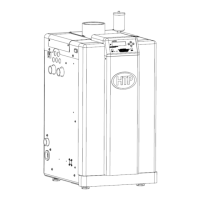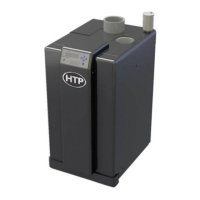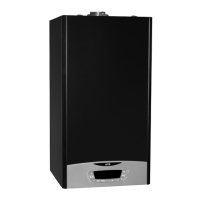LP-293 Rev. 9.24.15
59
Outdoor Sensor
(7250P-319)
Supply Temperature Sensor
(7250P-324)
Boiler Sensor
(7250P-667)
Indirect Sensor
(7350P-325)
Outside
Temperature
(
o
F)
Resistance
(ohms)
High / Low
Temp Sensor
Temp. (
o
F)
Resistance (Ohms)
-22 171800 32 32550
-13 129800 41 25340
-4 98930 50 19870
5 76020 59 15700
14 58880 68 12490
23 45950 77 10000
32 36130 86 8059
41 28600 95 6535
50 22800 104 5330
59 18300 113 4372
68 14770 122 3605
77 12000 131 2989
86 9804 140 2490
95 8054 149 2084
104 6652 158 1753
113 5522 167 1481
176 1256
185 1070
194 915
202 786
212 667
Table 28 - Sensor Temperature Resistance
The combustion chamber insulation in this product contains
ceramic ber material. Ceramic bers can be converted
to cristobalite in very high temperature applications. The
International Agency for Research on Cancer (IARC) has
concluded, “Crystalline silica inhaled in the form of quartz
or cristobalite from occupational sources is carcinogenic to
humans (Group 1).”
• Avoid breathing dust and contact with skin and eyes.
• Use a NIOSH certied dust respirator (N95). This type
of respirator is based on the OSHA requirements for
cristobalite at the time this document was written. Other
types of respirators may be needed depending on job
site conditions. Current NIOSH recommendations can
be found on the NIOSH website: http://www.cdc.gov/
niosh/homepage.html. NIOSH approved respirators,
manufacturers, and phone numbers are also listed on
this website.
• Wear long-sleeved, loose tting clothing, gloves, and eye
protection.
• Apply enough water to the combustion chamber lining
to prevent dust.
• Wash potentially contaminated clothes separately from
other clothing. Rinse clothes washer thoroughly.
NIOSH stated First Aid.
• Eye: Irrigate immediately.
• Breathing: Fresh air.
B. Combustion Chamber Coil Cleaning Instructions
*Before beginning this procedure, have on hand the following
items:
• a nylon, stainless steel, or brass brush (not steel)
• an FDA approved liquid lime scale remover in a spray
bottle
• gloves and eye protection
1. Shut down the boiler by using the following steps:
a. Close the gas valve. Shut down the unit, and wait for it to
be cool to the touch.
b. Disconnect the condensate piping from the outside
connection, (not from the boiler side), so ow from
condensate reservoir can be observed.
c. Disconnect electrical connections from the gas valve,
spark electrode, ame rectication probe, and combustion
blower.
d. Remove the four (4) screws on the aluminum ¾” NPT
connector on the right side of the gas valve.
e. Disconnect the wiring connected to the combustion
blower motor.
f. Remove the six (6) 10MM nuts from the burner plate
assembly.
g. Pull the entire burner plate assembly with blower still
attached towards you, while removing or pushing aside any
wiring to allow removal of the assembly.
2. Spray the coils liberally with the FDA approved liquid lime
scale remover. Conne the spray to the area being cleaned.
Avoid getting the ceramic target wall wet. If the condensate
system is blocked, use a vacuum to clear it.
3. Scrub coils of any buildup with a nylon, stainless steel, or
brass brush. Do not use a steel brush. Vacuum the debris from
the coils.
4. Spray the coils again with clear tap water. Conne the spray
to the area being cleaned. Flush the combustion chamber with
fresh water until it runs clear from the condensate reservoir. At
this point, the boiler should be ready to be reassembled.
a. Inspect gaskets.
b. Reinstall the burner assembly
c. Replace and tighten the six (6) 10MM nuts to the burner
plate using staggered tightening sequence. (See detail.)
d. Reconnect all wiring connections
e. Inspect the gas valve. Ensure the O-ring is in place.
f. Replace the four (4) screws on the aluminum connector on
the gas valve. Turn the gas back on. (IMPORTANT: CHECK
FOR GAS LEAKS!)
g. Turn boiler power back on and create a heat demand. When
boiler is lit observe condensate ow from the boiler. Be sure
the boiler is operating properly.
h. Reconnect the condensate piping to the outside condensate
connection.
Do not use solvents to clean any of the burner components.
The components could be damaged, resulting in unreliable or
unsafe boiler operation, substantial property damage, severe
personal injury, or death.

